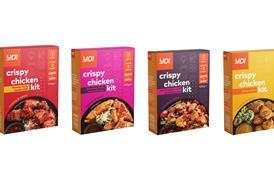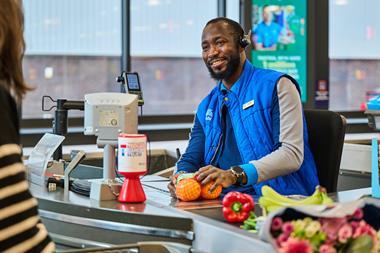The arrival of Aldi means Australia's big three are no longer going to have it all their own way. Barry Flanagan reports
Around Easter last year, recruitment ads started to appear in Sydney newspapers for managers to join one of the world's leading grocery retailers which was establishing itself in Australia. "Founded in Europe, the group is backed by thousands of stores in eight countries across Europe and America," the ads stated.
Only after property experts were hired to scour Sydney and New South Wales for retail sites of around 75,320 sq ft, with the stipulation each site should have a catchment area of over 20,000 people, was the industry positive that one of the world's largest food retailers was here Aldi, the privately owned German powerhouse.
Australia is as far from Aldi's home base as possible. And it has been this geographic isolation and a relatively small population of 19 million spread over a vast continent that has kept other big international food players at bay.
But Aldi has grasped an opportunity created over the last five years now that established discount chain Franklins has moved upmarket with the introduction of fresh food.
For more than 40 years Franklins, since 1979 part of the Dairy Farm group in Hong Kong, had owned the discount sector with a chain of cluttered stores on the east coast exemplifying its No Frills' way of doing business. Although it had no fresh food, Franklins customers were easily serviced by a myriad of butchers, fruiterers and bakeries surrounding each outlet.
But with the accelerated move in the mid 90s to extended trading hours in Victoria and New South Wales, Franklins' supermarkets were being forced to trade longer to compete with Woolworths, the Fresh Food People', and Coles, the supermarket arm of Coles Myer.
The family owned fresh food retailers it relied on so heavily did not have the resources to keep pace with its longer trading hours, leaving shoppers no choice but to move.
With no alternative, Franklins embraced fresh food with an emphasis on opening new Big Fresh' market style outlets or converting its No Frills stores into Franklins Fresh outlets. Franklins had been easily identified by shoppers as the cheapest grocer in town. But now that difference in pricing between the three chains is less than 1% and for most shoppers insufficient to make them switch.
With its deep discount offer across 600 own label ranges, Aldi now wants to grab the space vacated by Franklins and create a new power in Australian food retailing.To put the threat to the big three in context, the worldwide sales of Aldi at $US31bn are greater than the total food sales of Coles Myer, Woolworths and Franklins combined; bigger, indeed, than Australia's total packaged grocery market. Woolworths, the country's largest food retailer, only has annual supermarket sales of below $US10bn.
The big three, even so, have had it their own way up to now. They hold over 80% of packaged grocery compared to around 45% some 20 years earlier. They enjoy unprecedented market share, to the point where last year the Liberal federal government, at the behest of beleaguered smaller stores, undertook an extensive probe to determine whether the independents were facing extinction.
During the height of the investigation, the rumoured emergence of Aldi gave the chains an added argument in trying to stop the government from imposing any artificial limits or forcing the divesture of market share through the sale of their stores to the independent sector the key plea in the submission by the National Association of Independent Grocers of Australia and similar affiliated associations around the country representing small family owned food stores.
If Aldi were really coming to Australia, then obviously the big three's 80% share of the grocery cake was not a deterrent and other foreign operators could follow, they argued.
The inquiry virtually left the big three alone to pursue their quest for more and more market share, unimpeded by government regulations. But Aldi's unintentional help has turned into an ominous cloud.
Reg Clairs, who retired as Woolworths group md last year, is warning the industry that if it does not prepare for an invasion of other global retailers, in addition to Aldi, Australia's supply base will be in "tatters and our retailers stranded". He sees the big international retailers sourcing the cheapest supply globally, allowing retailers such as Aldi to sell processed grocery items 20% to 30% cheaper "than our currently competitive prices". "Unless we take this seriously and are prepared, this could and probably will have a devastating effect on all of us, both suppliers and retailers," Clairs says.
And Paul Simons who headed Woolworths from 1972 to 1978; was md of Franklins from 1979 to 1987; and then returned as executive chairman of Woolworths until 1995, when he retired labels Aldi as a "gorilla" whose entry into Australia will sweepingly change the whole food business. As a consequence, he forecasts the disappearance of Australia's trade funds relationship between retailers and manufacturers as they come in line with Aldi's style of doing business.
"It doesn't want any fuss such as promotional allowances, slotting allowances, all the things retailers have dreamt up over the last 20 to 30 years to get a little bit extra off the cost of the product," says Simons.
He says Australian retailers will have to become "lean and mean" to fight an operator here for the long haul.
Aldi's entry is expected to lead to the resurgence of specialist, independent butchers, fruiterers and delis, who will "live" next door to complement its limited ranges much the same as they did in Franklins' heyday.
With a $43m, 366,000 sq ft distribution centre nearing completion in Sydney, and in sight of the main distribution centre for Woolworths, Australia's largest food retailer, Aldi will have the capacity to easily service a mooted 100 stores in its initial thrust into New South Wales before branching out further on the eastern seaboard with other distribution centres in Victoria and Queensland.
However, Aldi could encounter some resistance from the Australian public to its predominantly own label offer, though as a private company it has time on its side
The Australian market has an extensive generic, and to a lesser extent, an own label offer, but shoppers have consistently been turning away from these low priced lines in favour of national brands.
Only in the last five years, in fact, have the chains and independents looked at an own label offer more expensive than generics, but cheaper than branded products.
Australia's extensive range of "generics" developed more than 30 years ago as the cheapest possible grocery range. Franklins still has its No Frills generics but because of their nature they cannot be elevated hence the decision to range First Choice as the chain's own label while keeping No Frills as the generic range.
In the case of Coles and Woolworths, they have been able to lift the quality and packaging of their former generic ranges to own label status, while introducing other private label ranges at the same time.
The independent sector has mainly the Black & Gold generics. These products are in cheap packaging; the quality is certainly much lower than branded products'; and from a customer's point of view the product is the same today as it was 20 or more years ago.
Currently, ACNielsen groups own label ( housebrands') and generics together as the market still has some way to go before the public understands the difference.
After peaking at 12.5% value share during the 1991-92 recession, generics/housebrands now hold just 10% of the packaged grocery market while branded products are growing at more than 5% year on year.
Aldi will also encounter the problem that for the Australians convenience far outweighs price when it comes to store choice, according to an ACNielsen survey. Australians also like spacious stores with extra services.
Aldi's first stores are expected to opened in the lower socioeconomic area of Fairfield in western Sydney where three sites are being developed. Fairfield Council city planners are looking to Aldi to give them the needed pulling power to revitalise their once vibrant but now decaying retail centres, particularly in Villawood.
In retaliation, Franklins has quickly turned an old No Frills store into a limited assortment format containing only about 1,400 lines predominantly No Frills and First Choice own label.
With most of the dry grocery displayed as cut case and on pallets, Franklins has gone as close as it can to duplicating an Aldi store with its Cheaper Choice store, but without the specialist logistics that drives the European deep discounter. And the other players are quickly beefing up their own labels and generics, asking suppliers for keener pricing for the inevitable price war once Aldi unveils its much anticipated format.
It's still early days, but whatever happens, the way of doing business in the Australian grocery industry has been changed for ever and the big winner will be the consumer.
Barry Flanagan is the publisher of Retail World, Australia
{{MANAGEMENT FEATURE }}
Close menu
- Home
- Retail & Wholesale
-
Products & Suppliers
- Back to parent navigation item
- Products & Suppliers
-
Product Categories:
- Back to parent navigation item
- Product Categories:
- Alcoholic drinks
- Bakery
- Cereals & breakfast
- Cheese
- Chicken & poultry
- Chocolate
- Confectionery
- Crisps, nuts & snacks
- Dairy
- Fish
- Fresh produce
- Frozen
- Household
- Meat
- Own Label
- Sauces & condiments
- Seasonal
- Soft drinks
- Vaping
- Vegan & plant-based
- World foods
- Suppliers
- People
- Reports & Data
-
Topics A-Z
- Back to parent navigation item
- Topics A-Z
-
Popular topics:
- Back to parent navigation item
- Popular topics:
- Cost of living crisis
- Crime
- Deposit Return Schemes
- Finance
- Government & Regulation
- Health
- Inflation
- Loyalty
- Marketing
- Mergers & Acquisitions
- New Product Development
- Sourcing
- Supply chain
- Sustainability & environment
- Technology
- Ultra Processed Foods
- Vaping
- A-Z all topics
- Content by type:
- Events
- Ask iA (beta)
- Subscribe now
Sign in to comment on this article
Not logged in before? Register for FREE guest access today.
You will be able to:
- Read more stories
- Receive daily newsletters
- Comment on stories
Advert



















No comments yet